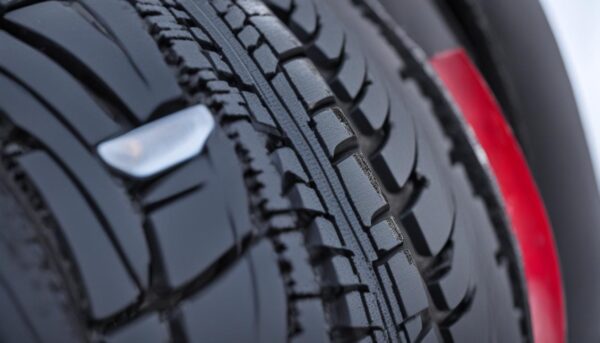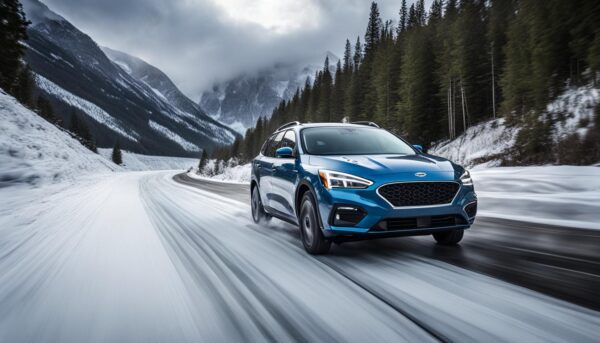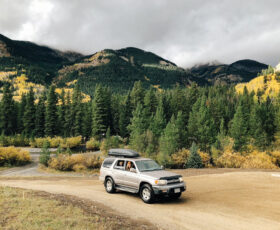Last Updated on 4 months
Unlocking the Secrets to Secure Winter Driving with the Best Snow Tires
When navigating slippery winter roads, the best snow tires can make all the difference in providing the necessary grip and traction for an enjoyable and safe driving experience. With the correct set of top-rated snow tires on your vehicle, you can confidently drive in snow and ice, as they are specially designed to handle extreme weather and road conditions. This article will explore the essential factors to consider when choosing the perfect snow tires for your vehicle, ensuring you maintain control and enhance your overall Winter driving confidence.
Key Takeaways
- Understanding the importance of snow tires for winter safety
- Factors to consider when choosing snow tires: size, fit, and type
- Top snow tire brands offering excellent performance and durability
- Comparing snow tires vs. all-season tires for winter driving
- Expert insights into snow tire traction and performance
- Maintaining and caring for your snow tires to maximize their lifespan
- Tips on where to find the best snow tires for sale
Unveiling the Importance of Snow Tires for Winter Safety
Winter’s risks of icy and snow-laden roads often overshadow Winter’s beauty. This season calls for snow tires for winter safety, which isn’t just another item on your car maintenance checklist but a crucial feature for your driving safety. Snow tires’ unique design and materials allow drivers to maintain traction and control in severe wintry conditions, making them indispensable to winter road safety. Investing in a quality set of snow tires could determine between a secure commute and a problematic drive.
Let’s explore some of the critical reasons why snow tires are essential for driving safely in Winter:
- Better Traction: Snow tires have deeper treads and specially designed patterns to provide maximum traction on slippery surfaces such as ice and slush. This is crucial for maintaining control and stability while driving in extreme weather conditions.
- Enhanced Braking: The technology used in winter tires enables shorter braking distances on icy and snow-covered roads, reducing the risk of collisions and accidents.
- Improved Handling: Winter tires improve the vehicle’s handling performance in cold temperatures, ensuring smoother and safer turns, acceleration, and overall maneuverability.
Investing in a quality set of snow tires could be the determining factor between a secure commute and a perilous drive.
With so many drivers on the road during Winter, it’s vital to take all necessary precautions, including equipping your vehicle with the right snow tires. Understanding the importance of having proper winter tires in place can significantly impact your overall driving experience, allowing you to drive safely and confidently in the coldest months of the year.
| Feature | Snow Tires | All-Season Tires |
|---|---|---|
| Traction on Snow and Ice | Excellent | Poor to Moderate |
| Braking Performance | Superior | Inferior |
| Handling in Cold Temperatures | Improved | Reduced |
| Driving Confidence in Winter | High | Low |
In conclusion, snow tires for winter safety are an irreplaceable element in ensuring a secure and comfortable driving experience during the frostiest months. Always prioritize safety and invest in high-quality winter tires to navigate icy roads and snowy terrains confidently.
Essential Factors to Consider When Choosing Snow Tires
When it comes to selecting the right snow tires for your vehicle, a few key factors must be taken into consideration. Tire size, specific symbols, and the choice between studded and studless options all play a vital role in your decision-making process.
Understanding the Role of Tire Size and Fit
One of the most critical aspects of choosing snow tires is ensuring the proper tire fit and size. Your vehicle’s manual or the sidewall of your current tires will indicate the specific dimensions you should follow. Aligning your snow tires with your vehicle specifications guarantees optimized performance while preserving your car’s safety features and handling.
Decoding the Three-Peak Mountain Snowflake Symbol
Another crucial factor is the Three-Peak Mountain Snowflake symbol on the tire’s sidewall. This symbol indicates that the tire meets the industry standards for severe snow conditions.
The Three-Peak Mountain Snowflake Symbol serves as an added assurance that your chosen snow tires are capable of performing well under extreme winter conditions.
Studded vs. Studless: Making an Informed Decision
When choosing between studded and studless snow tires, it’s essential to consider your typical winter driving conditions. Here’s a quick comparison:
| Type | Traction | Ride Comfort | Road Noise |
|---|---|---|---|
| Studded Snow Tires | Superior grip on icy surfaces | Less smooth on clear roads | Increased noise levels |
| Studless Winter Tires | Efficient performance in snow | Smooth ride on clear roads | Less noisy |
Both options have their pros and cons. Studded snow tires offer better traction on ice due to their metal studs embedded in the tire tread. Conversely, studless winter tires perform well in snowy conditions and are less noisy on clear roads. Carefully evaluate your driving environment and requirements to choose snow tires that suit your needs.
Top Snow Tire Brands Ensuring Your Winter Driving Security
The market boasts various esteemed snow tire brands, each offering features to enhance Winter driving safety. Brands like Nokian, Bridgestone, and Michelin are renowned for their high-performing winter tires, providing excellent traction, durability, and fuel efficiency.
As a guide to purchasing the best winter tires, we have compiled a list of some of the top snow tire brands and their highly rated models:
| Brand | Top Model | Features |
|---|---|---|
| Nokian | Hakkapeliitta R5 | Superior grip on ice and snow; low rolling resistance for improved fuel efficiency |
| Bridgestone | Blizzak WS90 | Impressive traction and control on ice, wet, and snowy surfaces; long-lasting performance |
| Michelin | X-Ice Snow | Excellent grip on icy and snowy roads; comfortable and quiet ride; enhanced durability |
Choosing a reliable tire brand ensures winter tire security and bolsters your confidence while driving in challenging winter conditions.
“Quality always comes first when looking for the best winter tires. Trusted brands offer the right combination of performance and longevity, giving you peace of mind on the road.”
Consider your driving environment, vehicle specifications, and budget when selecting the best winter tires. Being equipped with high-performing snow tires from industry-leading brands can make a substantial difference in your safety and driving experience during the year’s coldest months.
Examining Snow Tires vs. All-Season Tires: A Tactical Analysis
When choosing the right tire for Winter, drivers often debate between snow tires and all-season tires. Though all-season tires may be sufficient in regions with milder winters, offering versatility across various conditions, including light snow, snow tires become indispensable in areas with heavy snowfall and frequent icy roads.
Snow tires are designed to provide superior traction and control in winter conditions. They feature deeper tread depths and specialized designs optimized for cold temperatures and snowy terrains, outperforming all-season tires in terms of all-season vs winter tires performance comparison.
“When it comes to the tire choice for winter, always consider the typical weather conditions in your region. Opt for snow tires if you face heavy snow or icy roads often.”
To further illustrate the tactical advantages of snow tires over all-season tires, consider the following comparative aspects:
| Aspect | Snow Tires | All-Season Tires |
|---|---|---|
| Tread Depth | Deeper treads for improved grip on snowy surfaces | Shallower prints, best suited for milder winters or light snowfall |
| Tread Design | Specialized design for cold temperatures and snowy terrains | General design intended for versatility across conditions |
| Cold Temperature Performance | Designed to maintain flexibility in cold temperatures for better traction | Flexibility and traction may be reduced in extreme cold |
| Overall Winter Performance | Superior traction and control in heavy snow and ice | Satisfactory performance in light snow but reduced performance in more severe conditions |
Considering the aspects shown in the table above will enable you to make an informed decision and choose the right tire for your needs. Remember, your tire choice for Winter significantly impacts your driving safety and overall winter driving experience.
Expert Insights into Snow Tire Traction and Performance
When driving in the snow, achieving maximum tire traction is crucial for maintaining control and stability. To accomplish this, it is essential to understand the importance of snow tire tread depth and tread patterns for grip. This section will discuss the key factors contributing to better tire traction and performance in snow.
Evaluating Tread Patterns and Depth for Maximum Grip
One of the main factors that can influence snow tire performance and traction is the depth and design of the tire’s treads. Typically, a deeper tread depth contributes to increased traction on snowy roads. This allows the tires to compact the snow within the grooves and expel it efficiently, creating a more stable driving experience. Deeper treads also enable the tires to maintain better contact with the road surface, improving grip.
Another crucial aspect of snow tire traction is the design of tread patterns. Specialized tread patterns, such as complex siping designs, are engineered to increase the tire’s ability to grip icy surfaces. Siping involves making minor, intricate cuts in the tire’s tread blocks. These cuts create additional biting edges, facilitating improved grip on icy surfaces by pulling the ice into the grooves.
Tire brands use various other design techniques to maximize grip on snowy roads besides siping patterns. Some of these techniques include:
- Directional tread patterns help reduce hydroplaning by efficiently channeling water away from the tire and expelling it through the grooves.
- Winter-specific compounds include a higher percentage of natural rubber and silica, which allow the tire to remain soft and pliable in freezing conditions, ensuring improved traction and grip on cold surfaces.
- Wide circumferential grooves: These grooves contribute to better traction by allowing the tire to quickly expel water and slush, reducing the risk of hydroplaning on slippery surfaces.
“Snow tire tread depth and specialized tread patterns play a pivotal role in the tire’s overall traction and performance during wintry driving conditions.”
Ultimately, when evaluating snow tire traction and performance, it’s essential to consider the tread depth and design of the tire. By selecting a tire that offers the optimal combination of these features, drivers can enjoy a safer and more confident journey on snowy roads.
The Impact of Temperature on Snow Tire Efficiency

Temperature plays a significant role in the performance of snow tires, with cold weather conditions directly affecting the efficiency of these specialized tires.
Snow tires are made from a unique rubber compound designed to maintain flexibility in frigid temperatures, ensuring optimal traction.
Typically, when temperatures consistently fall below 45°F (7°C), it is the optimal condition for snow tire efficiency as the tires perform best in colder environments.
Timing the installation of your snow tires before the onset of Winter is crucial because it maximizes their performance during the months they are most needed. To understand the impact of temperature on snow tire performance, consider the following benefits offered by these tires when utilized in colder climates:
- Enhanced grip on slippery surfaces
- Improved control and stability
- Extended the lifespan of all-season tires by offsetting their usage in cold conditions
Given the importance of temperature in snow tire performance, monitoring weather conditions closely and gauging the right moment to switch from all-season tires to their snow-exclusive counterparts is essential. As a rule of thumb, installing your snow tires as soon as consistent low temperatures are anticipated is best.
| Temperature Range | Tire Type | Traction Efficiency |
|---|---|---|
| Above 45°F (7°C) | All-Season Tires | Optimal |
| Below 45°F (7°C) | Snow Tires | Optimal |
In conclusion, the temperature effects on snow tires are vital in determining their efficiency and ability to maintain optimal traction. Drivers must ensure their snow tires are correctly installed to benefit from the superior snow tire performance and cold-weather tire efficiency that Winter challenges demand.
Calculating the Right Time to Install Snow Tires
Finding the best time for snow tire installation is about adapting your vehicle for the winter months and proactively preventing potential safety hazards. While each region may exhibit different temperature patterns, a general rule is to install winter tires when the average temperature consistently drops below 45°F (7°C). This choice helps drivers prepare for Winter and adapt to ever-changing road conditions.
In addition to temperature, some motorists monitor their area’s first freeze or snowfall dates, using these markers as a catalyst for snow tire installation. The key to success is being prepared in advance, ensuring your vehicle is ready to tackle unexpected winter storms with optimal tire performance.
Installation Tip: Schedule your tire installation appointment early in the season, as tire shops often experience a high demand during early winter months.
- Monitor average temperatures for consistent readings below 45°F (7°C).
- Be aware of local weather reports, noting first freeze or snowfall dates.
- Book your appointment early to avoid appointment delays and shortages.
Creating a systematic plan is vital to ensure your vehicle is prepared for the onslaught of winter conditions. By choosing the perfect time for winter tire installation, you’ll be ready to handle a variety of winter roads with both confidence and control.
The Investment in Quality: Budgeting for the Best Snow Tires

While budget constraints may tempt drivers to seek cheaper options, investing in high-quality snow tires can substantially improve your safety and vehicle performance. Renowned brands like Nokian, Bridgestone, and Michelin may cost more upfront. Still, they provide long-term value through durability, enhanced fuel efficiency, and, most importantly, reliable performance under challenging winter conditions.
Investing in quality winter tires is an investment in your safety, and it’s worth every penny.
To understand the value of putting a significant budget for snow tires, let’s take a closer look at some of the benefits they offer:
- Durability: Quality winter tires often come with a longer tread life, making them more cost-effective in the long run.
- Fuel efficiency: Superior snow tires boast a lower rolling resistance, which translates to better fuel economy.
- Dependable performance: Trustworthy brands are designed and tested for maximum traction and control in extreme winter conditions.
| Brand | Tire Model | Average Price |
|---|---|---|
| Nokian | Hakkapeliitta R2 | $180 |
| Bridgestone | Blizzak WS80 | $130 |
| Michelin | X-Ice Xi3 | $150 |
Although high-quality winter tires can be more expensive, they are cost-effective through improved performance, enhanced safety, and lower maintenance costs. The snow tire costs should always be weighed against their vital contributions to your driving experience during the winter season.
Remember, your safety and the safety of your passengers should always be a top priority. Allocating a sizeable budget for snow tires is a wise decision to protect yourself and your loved ones from the risks associated with winter driving.
Mastering Winter Conditions: Maintaining and Caring for Your Snow Tires
Routine snow tire maintenance is critical to ensuring the longevity and performance of your snow tires. Regularly checking the air pressure, inspecting for wear or damage, and ensuring they are appropriately stored during the off-season contribute to tire durability. Keeping track of tread depth is also crucial, as this can significantly affect traction and the overall effectiveness of your snow tires in winter conditions.
Proper care for winter tires involves more than just visual inspections. The following are some maintenance tips that can help guarantee lasting tire performance:
- Regularly check and adjust tire pressure according to the manufacturer’s recommendations.
- Rotate your winter tires every 6,000 to 8,000 miles to ensure even wear.
- Use a depth gauge to measure tread depth and, if necessary, replace your snow tires when the depth falls below 4/32 inches.
- Balance your tires to avoid uneven wear and improve overall handling and ride comfort.
- Clean your tires by removing any rocks, glass, or other debris caught in the treads.
- When storing your snow tires during the off-season, please keep them in a cool, dry place away from sunlight, heat, and ozone sources.
Remember: tires are the only contact your vehicle has with the road, so proper snow tire maintenance is essential for your safety on winter roads.
Finally, it’s always a good idea to consult your tire manufacturer or owner’s manual for recommendations specific to your brand and model. Each tire may have particular maintenance requirements, and adhering to these guidelines can ensure a smoother, safer winter driving experience.
| Snow Tire Maintenance Tip | Action |
|---|---|
| Check and adjust tire pressure | Follow the manufacturer’s recommendations |
| Rotate tires | Every 6,000 to 8,000 miles |
| Measure tread depth | Replace when below 4/32 inch |
| Balance tires | Prevent uneven wear and improve handling |
| Clean tires | Remove debris from treads |
| Store tires properly | Keep in a cool, dry place away from sunlight and heat |
In conclusion, a proactive approach to snow tire maintenance and proper care for winter tires will help you get the best performance and longevity out of your investment. This, in turn, will ensure your safety and confidence while driving in various winter conditions.
Ready to Buy: Where to Find the Best Snow Tires for Sale
Purchasing snow tires is accessible from various outlets, ensuring you are ready for winter driving. Knowing where to buy snow tires and researching options is essential to finding the perfect set for your vehicle and driving conditions. Explore different avenues, from online retailers to reputable tire shops.
1. Online Retailers
Convenient and often more affordable, purchasing winter tires online is a popular option. Websites such as Tires-easy offer a broad selection and competitive prices, allowing you to browse, compare, and buy snow tires from the comfort of your home. Most online retailers provide shipping services, delivering the tires straight to your doorstep or a nearby installer.
2. Reputable Tire Shops
Local tire shops provide the opportunity for professional consultation and may carry a wide range of snow tires. Consult with the experts to ensure you’re choosing the right tire for your needs, and take advantage of the added benefit of immediate installation.
Regardless of the purchasing method, it’s essential to research and compare options when looking for snow tires for sale. Please consult the table below for an overview of some top snow tire brands and their famous winter tire models.
| Brand | Popular Winter Tire Model | Features |
|---|---|---|
| Nokian | Hakkapeliitta R5 | Optimized for grip and handling in icy conditions |
| Bridgestone | Blizzak WS90 | Superior performance in snow and slush |
| Michelin | X-Ice Snow | Solid grip on both snow and ice, durable and fuel-efficient |
| Continental | VikingContact 7 | Excellent traction and control in winter weather conditions |
By knowing where to buy snow tires and selecting the correct set for your vehicle, you are making a wise investment in your driving safety during the winter months. Take the time to research, compare, and consult professionals to guarantee optimal performance, traction, and control in your winter tires.
Conclusion
In conclusion, proper snow tire selection ensures Winter driving safety and overall confidence on the road. When choosing snow tires, it is essential to consider factors such as tread type, size, driving conditions, and the presence of the Three-Peak Mountain Snowflake symbol. By making an informed decision, drivers can purchase the best snow tires to meet their individual needs and confidently navigate slippery, snow-laden roads.
High-quality snow tires provide the traction, control, and reliability to face challenging winter conditions. Brands such as Nokian, Bridgestone, and Michelin offer top-rated snow tires that have been rigorously tested and proven to perform well in extreme conditions. Investing in such reputable brands can ensure long-term value and safety for drivers facing snowy climates.
Ultimately, making the right choice in snow tires is an investment in your safety and the longevity of your vehicle’s performance through the winter months. By researching and comparing various options, you can enjoy peace of mind knowing that you are equipped to handle whatever winter road challenges come your way.
FAQ
What is the significance of the Three-Peak Mountain Snowflake Symbol on snow tires?
The Three-Peak Mountain Snowflake symbol on the sidewall of snow tires denotes that the tire meets predetermined industry standards for severe snow service. This means it has been tested and proven to perform well under extreme winter conditions.
When should I install snow tires on my vehicle?
Installing snow tires when the average temperature consistently drops below 45°F (7°C) is recommended. Installing them before the first freeze or snowfall can help ensure your vehicle performs optimally on wintry roads and prevent safety hazards.
How do snow tires differ from all-season tires in winter conditions?
Snow tires outperform all-season tires in terms of traction and control in Winter due to their deeper tread depths and specialized designs optimized for cold temperatures and snowy terrains.
What is the difference between studded and studless snow tires?
Studded snow tires have metal studs embedded in the tread that offer superior grip on icy surfaces, while studless snow tires provide efficient performance in snow and are less noisy on clear roads. Consider your typical winter driving conditions when choosing between the two types.
What should I look for in tread patterns and depth when selecting snow tires?
Deeper treads and specialized patterns with complex siping are critical for snow tire performance. Deep impressions provide the necessary grip on snowy roads by compacting and expelling snow efficiently, while siping patterns create additional biting edges for improved grip on icy surfaces.
How do temperature changes affect snow tire efficiency?
Snow tires are made from a rubber compound that remains flexible in cold temperatures, providing better traction in winter conditions. When temperatures consistently fall below 45°F (7°C), it is the optimal condition for snow tire efficiency.
How can I maintain my snow tires for optimal performance and longevity?
Regular maintenance is crucial for snow tire performance and durability. Check air pressure routinely, inspect for wear or damage, store properly during the off-season, and track tread depth to ensure the tires continue to provide traction and effectiveness in winter conditions.
Where can I buy snow tires?
You can purchase snow tires from online retailers like Tires-easy or reputable tire shops. Researching and comparing options is essential to ensure you choose the right tire for your driving conditions and needs.
Source Links
- The Best Winter And Snow Tires You Can Buy
- Best Snow Tires For Winter: Top Secrets For Driving Confidence









